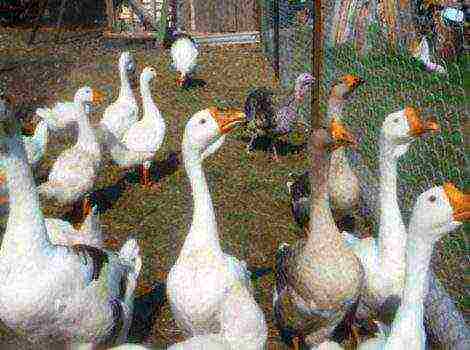Content
- 1 Basic methods of growing champignons at home
- 2 Substrate preparation
- 3 Harvesting
- 4 Video: Recommendations and Tips
- 5 Conditions for growing champignon mushrooms
- 6 Preparing compost for growing mushrooms
- 7 What should be the mushroom mycelium
- 8 Technology for growing mushrooms in the basement (in bags)
- 9 Technology for growing mushrooms in the country (in a greenhouse, in a garden)
- 10 Growing champignons at home (on the balcony)
Posted by: Anything different
How to start a business for an entrepreneur? There is no money, premises, equipment. There is only an entrepreneurial itch and a desire to "get into people as soon as possible." You can also accumulate initial capital at home. No, not a telephone pimp or a free broker, but a completely harmless occupation - growing mushrooms.
Is there a balcony? Then get down to business. Glaze the balcony, put together a wardrobe with shelving, build drawers 20 centimeters high. Do not forget to make a ventilation pipe with a valve in the cabinet, and put an electric kettle below - it will simultaneously heat the cabinet and create optimal humidity.
Champignon mycelium (seedlings) can be bought in specialized shops for gardeners. It costs a penny, and a kilogram of mushrooms is $ 3. For a year, you will receive up to 120 kg of an appetizing product - this is 360 USD. Profit, taking into account the invested labor, minus the cost of electricity, manure and mycelium - net 300 USD.
Be sure to set aside some of the funds for the expansion of production. Buy scales, overalls. How to prepare a substrate for growing mushrooms? Here is a recipe for you: 10 kg of straw, 15 kg of bird or ordinary manure, 8 kg of alabaster. To increase the yield, add mineral fertilizers to the substrate at the rate of 10 kg of straw, 200 g of urea and 200 g of superphosphate. All this is mixed in warm water, and to maintain constant moisture on the sides of the boxes you add moss. After mixing all the components in the substrate, the fermentation process will begin and its temperature will rise to 60 - 70 degrees. This process will last about three weeks, after which the substrate will be ready for sowing with mycelium. In winter, insulate the wardrobe with mats made from an old blanket or straw.
Mycelium (mycelium) is commercially available for compost and grain. In balcony conditions, it is more convenient to use grain mycelium. The process of sowing mycelium is as simple as a rake. Take a handful of mycelium and sprinkle it evenly on the surface of the substrate and sprinkle on top with a layer of the same substrate 4 - 5 cm thick. For one square meter of the substrate area, you will need 350 grams of grain mycelium.
During the period of mycelium germination, the air humidity on your balcony should be within 80 - 90%. The optimum temperature is within 22 - 27 degrees. This is where you need an electric kettle. You just need to fill it with water and turn it on. To maintain the temperature and humidity conditions, you can regulate the heating of the kettle and slightly open the window on the balcony.
After ten days, when the mycelium has already grown, cover the surface of the substrate with a specially prepared soil. It can be prepared from a mixture of peat and chalk in a 10: 1 ratio. The thickness of the layer of this soil should not exceed 4 cm. Four days after filling the casing layer, the temperature in the room can be lowered to 15 - 17 degrees. Moisten the surface of the soil constantly through a conventional sprayer, but avoid flooding the substrate with water. Ventilate your balcony regularly, while being careful not to create drafts.
Harvest the whole year round. The fruiting period is 50-60 days. Collect mushrooms every other day. Mushrooms should be carefully twisted out of the ground so as not to damage the mycelium.Take mushrooms with intact peri-pectoral film, old and damaged mushrooms are not suitable for consumption - there is a risk of poisoning. Carefully fill the pits left over from the removed mushrooms with soil. All other details can be found in the available literature.
And another tip: sell products in beautiful packaging with your address and phone number. The buyer is more willing to deal with a familiar supplier. You can stick the recipe on the bag: what can be made from champignons. Soup, porridge with mushrooms, zrazy, cutlets. Mushrooms can be pickled, dried, etc.
Get down to business more boldly. Money is lying under your feet.
Tell your friends about the article and the site. Just press the button of your favorite social network ...
Thanks!!!
Have you noticed a mistake in the text?
Select it with the mouse and press Ctrl + Enter
 Mushrooms are a healthy product that also has excellent taste. They are quite deservedly in demand, are widely used in cooking as an independent dish, as well as in soups, side dishes and as part of various sauces and gravies.
Mushrooms are a healthy product that also has excellent taste. They are quite deservedly in demand, are widely used in cooking as an independent dish, as well as in soups, side dishes and as part of various sauces and gravies.
In stores, fresh mushrooms are mostly presented in two types - oyster mushrooms and champignons. They are easy to grow artificially. This can be done not only on an industrial scale at large production rates. It turns out that it is possible to do this in your own basement.
Recently, more and more consumers are interested in how to grow champignons at home.
Basic methods of growing champignons at home
There are several ways to grow mushrooms. Some of them are suitable for owners of their own houses and land plots, and some of them can be realized even on the balcony of a multi-storey building.
- The first is the mycelium in the garden. A place for it can be equipped in a greenhouse or basement, maintaining the required temperature (22-28 degrees) and high humidity (50-60%). A film is spread on a flat floor, about 40 cm thick compost is poured onto it, then mycelium is sown into the recesses and covered with a thin (up to 5 cm) layer of compost. After that - extremely regular and abundant watering. The undoubted plus of this method is its cheapness and simplicity. However, there is a high probability of infection of mycelium with infections, especially those brought from the street on a person's clothes or shoes. In this case, the entire bed becomes infected, and in most cases it is not possible to save it. In addition, harvesting will have to be done with a low bow, which will negatively affect the condition of the spine.
- The second method is to grow in boxes on shelves. Convenient, clean, the area of the room is used more rationally. Watering of such mycelium is done by drip systems. Due to the use of special equipment, this method requires large financial investments, so it cannot be called the most popular.
- The third method is bag cultivation. The finished compost is tamped tightly into a plastic bag and filled with abundant water. Outside the container, holes about 10 cm in diameter are made around the entire perimeter, preferably in a checkerboard pattern, into which the mycelium is planted. If suddenly an infection gets into such a bag, then it is disinfected or simply taken out without harming the rest of the mushrooms. This is a definite plus of this method. The downside is the need to use physical force when tamping bags.
- Growing mushrooms at home is possible even on the balcony. For this method, there are special aerated boxes equipped with a lid and a pallet. They are lightweight, compact, but expensive. Therefore, they are unlikely to be suitable for growing mushrooms for sale, but for the needs of an ordinary family, a couple of such containers can comfortably fit on a balcony or loggia.
- A very convenient way is to grow mushrooms in special briquettes. They are sold ready-made, which avoids the laborious and often impossible process of preparing the substrate for a city dweller.Briquettes of rectangular or cylindrical shape contain manure, peat, sawdust and seed husks, well mixed and, moreover, in optimal proportions. They are placed in containers or simply hung. About 80% of the harvest falls on the first 3-4 waves of growth, after which the used briquette is simply replaced with a new one. Expensive but extremely clean, hassle-free and comfortable. Frequent change of briquettes will allow you to constantly get a high yield of mushrooms.
Substrate preparation
 Growing champignon mushrooms at home is impossible without preparing a high-quality substrate for mycelium. This is a laborious process, moreover, due to the unpleasant odor, it is carried out only in air.
Growing champignon mushrooms at home is impossible without preparing a high-quality substrate for mycelium. This is a laborious process, moreover, due to the unpleasant odor, it is carried out only in air.
To prepare it, you need manure, preferably horse manure (if not, mullein or bird droppings), wheat or rye straw, dry leaves or corn stalks, as well as chalk, urea, gypsum and superphosphate. The composition can be slightly changed: black soil and sunflower husks are suitable as an addition.
Straw, previously soaked in water, or other organic matter - is mixed with manure, watered abundantly. The processes of mixing and abundant watering are repeated several times. At the same time, one of the additional components listed above is added each time. After that, the compost needs to be left for 20 days - this time is enough for it to "burn out".
Harvesting
Fruiting begins about a month and a half after the mycelium is laid. Young mushrooms with a whole film that has not broken through are carefully twisted (do not cut off!), Sprinkling the holes with earth.
The crop ripens in waves - up to seven times at intervals from 4 days to a week. The first three waves are the most productive. Up to 12 kg of mushrooms can be collected from one square meter of mycelium.
Video: Recommendations and Tips
Well, at the end, we suggest you watch an interesting video, which gives practical advice and recommendations regarding home cultivation of champignons:
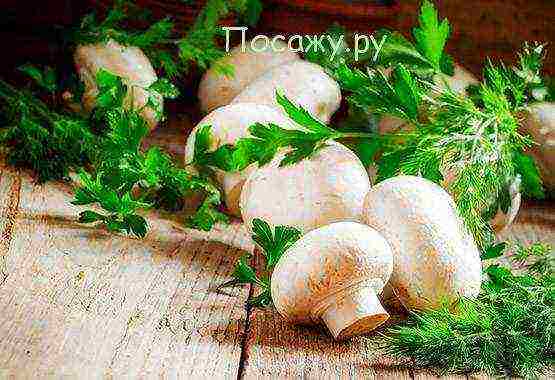
How to grow mushrooms at home
Champignons have become the most popular mushrooms in recent years. On supermarket shelves, they can be seen raw, frozen, pickled. And the huge number of dishes that can be prepared from these mushrooms is simply innumerable!
But the popularity of champignons is explained not only by their widespread use in cooking, but also by their relative unpretentiousness in the cultivation process. This process is not time consuming. The premises can be chosen practically of any type - both closed and open. These mushrooms are grown both at home and in the basement and in the open field. Perhaps, they do not like only dense thickets. But where they feel free and good is where there is a lot of manure and household waste. Champignons also feel good under a loose soil layer.

However, creating the same favorable conditions for mushrooms in a place convenient for the gardener is not always so easy. And many are interested in the question - how to grow mushrooms at home?
On average, the plate of each champignon has about 16 million spores. Each of them is a potential mycelium. But in order for the mycelium to form, several conditions must be met. Firstly, numbers from +23 to +25 degrees are considered the best temperature values for this process. However, this is for formation. But for the growth of fruiting bodies, the conditions must be different - the temperature must be constant, without any changes, and it should be maintained within 15-17'C.
The second prerequisite for growing mushrooms is the constant access of fresh air, which is why they love wildlife so much. Even lighting does not play such a role for them as excellent ventilation. In this case, drafts are extremely undesirable.
And the third important condition, without taking into account which it is impossible to grow mushrooms at home with good results, is maintaining a stable moisture level strictly in the range from 75 to 85%.This applies to all stages of development and growth.
There is the following statistics: from one square meter in Russia, farmers get 8 kg of mushrooms, and in the Netherlands - 25 kg ... Therefore, our mushroom growers began to adopt the experience of the Dutch. But the shelf system they propose to implement is very expensive due to the need for mechanized equipment. Therefore, if you are an amateur mushroom picker and are not going to grow mushrooms on an industrial scale, use your balcony for this purpose (it must be insulated and glazed).
Knock down a kind of cabinet with shelves and drawers about 20 cm high from unnecessary boards. Be sure to make a ventilation pipe with a valve in it. And to maintain the humidity level necessary for the mushrooms, install a humidifier (a simple electric kettle can be adapted for this purpose).
Next, you need to cover the boxes with moss and prepare a nutrient mixture, which will require 5 components:
- bird droppings - 15 kg;
- straw - 10 kg;
- building fine-grained gypsum - 8 kg;
- mineral phosphorus fertilizer (superphosphate) - 0.2 kg;
- urea - 0.2 kg.
Dissolve the substrate components in warm water. And leave to ripen for three weeks.
After that, spread the grain mycelium as evenly as possible on the substrate. And again sprinkle with the substrate, making a layer about 4 cm thick.Use the following ratio - 350 g of mycelium per 1 sq. meter area of the nutrient mixture. After a week and a half from the moment of germination of the mycelium, it is necessary to place a casing layer on top of it - a 4-cm layer of a mixture of peat and chalk in proportions of 10: 1. After five days on the balcony, you need to reduce and constantly maintain the temperature at 17 degrees. Do not forget about watering as well, the earth should not dry out. In this case, the fruiting period is about two months, the harvest is year-round.
Compost for growing mushrooms
To harvest a decent crop, you need to prepare a good nutrient mixture (substrate) for the mushrooms.
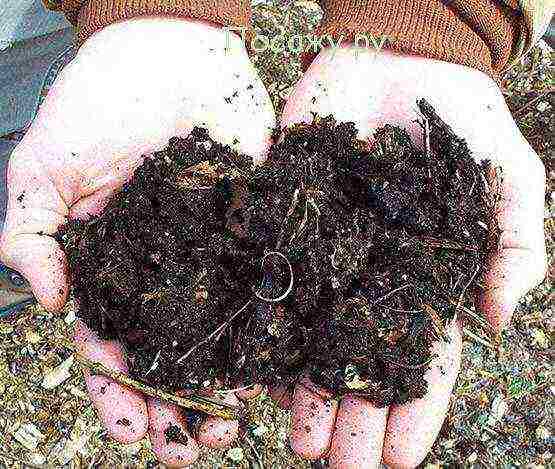
Its composition may vary, but we will give the most popular option:
- horse manure (or chicken droppings) - 300 kg;
- straw - 100 kg;
- mineral (calcium sulfate hydrate) - 8 kg;
- chalk - 5 kg;
- urea - 2 kg;
- superphosphate - 2 kg.
These proportions are relevant for a mycelium with an area of 3 square meters, and you have already adjusted it to fit your size.
Prepare the substrate outdoors. Pre-fill the straw with water and leave for 24 hours, then place it with horse manure in layers in a stack of 1.5 x 1.5 x 1.2 m.In each straw layer, you must first add superphosphate and urea, and then chalk and gypsum.
Planting champignons: mycelium
For the cultivation of these mushrooms, it is not spore propagation (as it happens in the wild) that is used, but the vegetative method - with the help of pieces of mushroom tissue. If you want to grow your mushrooms, for example, in the country, you will need mycelium. These so-called "mushroom seedlings" can either be purchased or grown by yourself. Choose a method that is convenient for you. The main thing is that the mycelium is healthy, sterile, without any visible damage to the eye.

To grow it, dip a part of the mushroom fruiting body with tweezers into a test tube with one of the types of agar. Cover tightly with gauze or cotton wool and send to the thermostat for 14 days, maintaining the temperature at +24 degrees throughout the entire time. The resulting stock culture is then transplanted into Petri dishes, maintaining a stable temperature of + 2'C until inoculation.
In the future, already sterilized glass jars are used. Put the boiled grain on their bottom, and distribute the mycelium over it. Send it back to the thermostat until the grain is completely overgrown with mycelium.To obtain the best result, it is important to constantly maintain a favorable temperature of + 24'C and pay special attention to sterility, so that larvae of pests and pathogens of various diseases do not get into the mycelium.
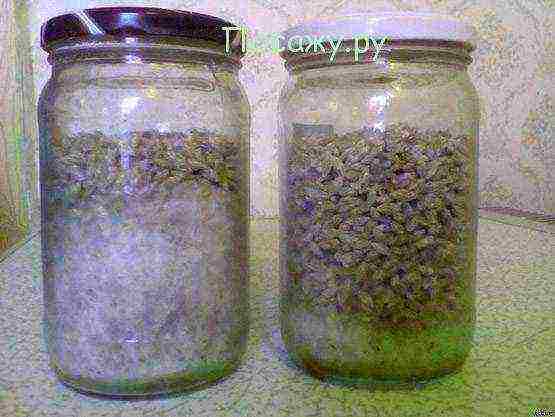
Growing champignons in the basement
Yes, these mushrooms are also grown in the basement in bags! Despite the fact that this method is best known for oyster mushrooms, in recent years it has been actively used to grow mushrooms.
It attracts with a minimum of material costs (no need to purchase containers), and also allows you to fight infections with relative ease - an infected bag is either disinfected or thrown away, while others remain unaffected by bacteria. But at the initial stage, you still have to work hard. At the same time, if you prepare the compost correctly, have good quality planting material and create the necessary microclimate in the basement, you can safely count on a high yield!
For growing mushrooms in bags, it is better to choose a two-ring or double-pore. Meadow champignon, Hauser A15, Somycel 512 are also suitable. These varieties can be called unpretentious and quite simple in terms of care, while you will be pleased with the yield indicators.
So, first, decide on the room. The basement (closet, cellar) is good because it is damp, dark, cool, and at the same time there are no sudden temperature fluctuations, which champignons do not like so much. However, do not forget about other important conditions:
- the floor must be made of concrete;
- ventilation must be very good, while it is important to reduce the likelihood of drafts;
- to adjust the humidity level, spray the floor / racks with a spray gun;
- to fix a favorable temperature for mushroom growth (15-17 degrees above zero), heaters or air conditioners can be used;
- before planting mushrooms, it is imperative to disinfect the basement (treat it from mold and various parasites), and then thoroughly ventilate it;
- you need lighting more than champignons, so one ordinary light bulb under the ceiling will be enough.
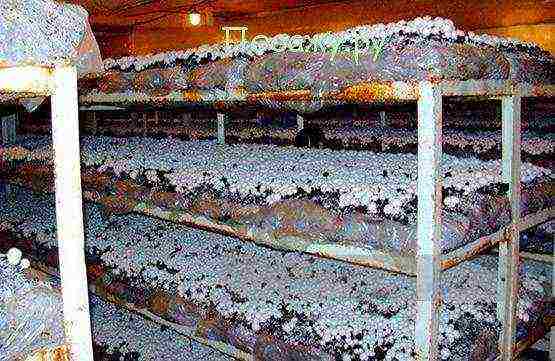
For basement cultivation, it is advisable to prepare a substrate of the following composition:
- horse manure - 15 kg;
- black soil - 6 kg;
- straw - 3 kg;
- mullein - 2 kg;
- sunflower husk - 2 kg.
Mix all these components thoroughly, fill with plenty of water. Cooking times can vary from three to four weeks (20-28 days). The substrate temperature during fermentation can reach +50 (and even +80) degrees. However, for growing mushrooms in the basement, its temperature should be no more than + 25'C. Now dry the soil mixture by spreading it in a thin layer.
Then everything is simple - fill the bags to the very top, tamping the contents well. Fill with water to achieve the maximum moisture content of the mixture.
Make a "checkerboard grid" on the bags - in this order (to avoid rupture of the bag), make holes about 10 cm in size. Then place the mycelium in each formed cell.

How to grow mushrooms outdoors
Most of the farms that grow these mushrooms in OG rely on the sale. Here, material costs for special equipment are inevitable, which are completely unnecessary for those mushroom growers who are engaged in this type of activity at an amateur level.
In addition, outdoor cultivation is best done in regions where the frost-free period exceeds 6 months. There are other complications compared to the basement method. In an ordinary garden bed, it is much more difficult to protect mushrooms from sudden temperature fluctuations that are destructive for mushrooms. It will be a shame to lose most of the harvest due to frost, having invested your time and work. The likelihood of various diseases also increases due to the fact that there are a lot of parasites in the open field.
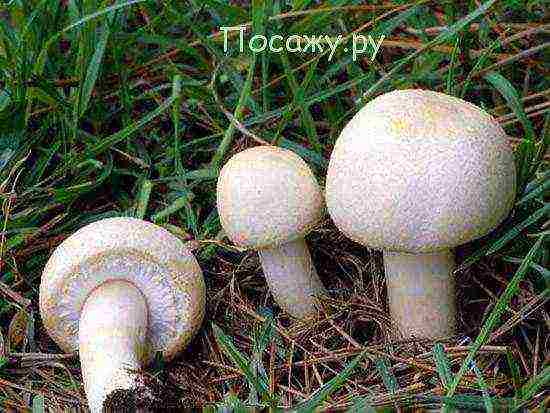
However, if you do not have a good basement room, and you do not intend to give up your mushrooms, then let's still talk about how to grow champignons in the country and, in general, any open area. Here the choice of varieties is so wide that the eyes run up! By the way, brown varieties are suitable, which are much less common.
This method is rather unusual, because zucchini will have to be grown along with the mushrooms. So, first of all, dig up the ground and fertilize it with manure (you can use both cow and horse manure). Make ridges up to one and a half meters wide. Plant squash seedlings and form a kind of small greenhouse for it - install metal arcs, cover them with foil. Add the mycelium between the bushes of overgrown zucchini. Next, focus on moisturizing the soil. With the right approach, you will not only get a harvest of mushrooms, but also zucchini!
At the summer cottage, it will be convenient to form a mycelium on an artificial substrate. Perhaps this method will seem more acceptable to you. First, remove about 25 centimeters of the earth layer in the place allocated for growing mushrooms. Make convex beds, but narrower than in the first case (one meter wide is enough). Dilute a 0.5% carbation solution and apply it to the soil. Then place a 20 cm layer of the prepared nutrient mixture on top of it. To prevent the mycelium from drying out over the ridges, make a canopy. Then wait for the 25-degree temperature of the substrate at a depth of 5 centimeters, make neat wells and put the mycelium in them. If you are using grain mycelium, then proceed as follows - scatter it over the surface of the soil, lay a 3 cm layer of the nutrient mixture on it, and then tamp it.
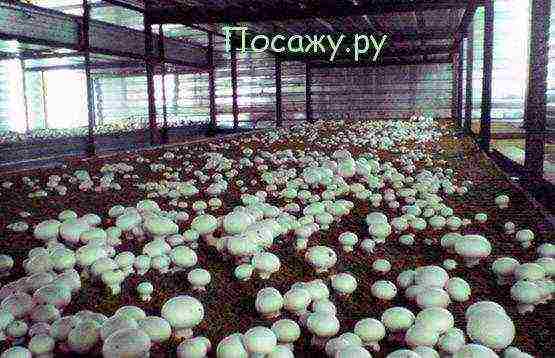
Now that you know how to grow mushrooms at home, in the basement and in the open field, you just need to calculate your strength, choose the most suitable method for you and get down to business. And a decent result will not be long in coming!
How to enjoy the familiar taste of your favorite mushroom dishes without spending money on expensive overseas crops? The answer suggests itself - grow mushrooms yourself! Read in our article all about the intricacies of planting and caring for mushrooms.
Champignons are the most widely cultivated mushrooms in the world. The process of growing mushrooms does not take much time, and in return you get a tasty and easy addition to main courses and a healthy snack. You can grow mushrooms almost anywhere, indoors and outdoors, the main thing is to observe the required temperature and humidity level. We will tell you about other intricacies of growing and caring for mushrooms below.
Conditions for growing champignon mushrooms
In nature, it is difficult to find places where champignons would not take root. There are none, except perhaps in dense forest thickets. These mushrooms grow everywhere: in humid forests, near water bodies, in mountainous, desert areas, in the steppe, and even accidentally in gardens or vegetable gardens. But more often than not, an undemanding mushroom can be seen on dung heaps, near household and natural waste dumps. Separate myceliums form close to human habitation, next to livestock pens and under loose soil. The plate of one mushroom contains over 16 million spores, each of which is a potential mycelium and a whole fungal family.
In total, more than 200 types of champignons are known, of which about 50 are used in mushroom growing.
However, what grows well in the wild does not always take root in "greenhouse" conditions. For the formation of mycelium, the optimal temperature is 23-25 ° C, but for the growth of fruiting bodies, it is best to maintain the ambient temperature within 15-17 ° C. The second mandatory requirement is good ventilation, but without drafts and temperature changes.Champignons need fresh air, sometimes even to the detriment of lighting, since they can grow in the dark. But the level of humidity at different stages of fungal development should be stable and range from 75 to 85%.
Preparing compost for growing mushrooms
For the growth and development of mushrooms, you can prepare a nutrient mixture from different components. It is very important to cook properly substrate for growing mushrooms and at the same time observe all proportions. Otherwise, a bountiful harvest may not be expected. More often than others, the composition described below is used for growing champignons.
For 100 kg of straw, take 2 kg of urea and the same amount of superphosphate, 8 kg of gypsum and 5 kg of chalk. Then add 300 kg of horse manure. The specified amount of the substrate is enough to lay the mycelium on an area of 3 sq. M. Prepare a nutrient mixture outdoors, soak the straw for 24 hours, and then stack it in layers with the manure in a small pile. Stack dimensions: length and height - 1.5 m, width - 1.2 m. Add urea and superphosphate to each layer of straw and mix the whole mixture well. Then add plaster of Paris and chalk.
Chicken manure can be used as an alternative to manure.
The overripe substrate is ready for mushroom cultivation in 20-25 days.
There is one more method of growing mushrooms in an open bed. Choose a location in the shade of your home, near a fence, or under trees. Dig a hole about 1 m wide and 40-50 cm deep and cover it with plastic. Pour the rotted compost into it and add the mycelium. Then cover it with a layer of casing layer and place a small canopy of translucent polyethylene over the mini-bed, or cover the bed with straw. From such a small garden bed it is possible to collect up to 3 kg of mushrooms.
In the open field, mushrooms are practically not grown - they still build sheds or greenhouses for them
If you are planning growing champignons for sale, then the volumes of harvested mixtures need to be increased. So, for 1000 kg of straw, 700-800 kg of chicken manure, 50-60 kg of gypsum and about 1000 cubic meters of water should be taken. This mass is kept for 25-30 days, and then you can start planting the mycelium.
What should be the mushroom mycelium
In the wild, champignons reproduce by spores, and for cultivation, individual pieces of mushroom tissue can be used (i.e., the mushrooms can be propagated vegetatively). Everyone who wants to grow mushrooms on the site has two options for acquiring the coveted mycelium: buy mycelium for growing mushrooms and find it yourself or grow it at home. It is, of course, easier to buy, but you will not know in what conditions the mycelium was grown, moreover, you will have to overpay for the purchase of a ready-made mycelium. Therefore, more often "mushroom seedlings" are planted on their own. To do this, either spores are sown, or they are isolated from the fruiting body of the fungus. The following are used as a nutrient medium for growing mushrooms:
- wort agar - for the manufacture of this substrate, 1 liter of beer wort and 20 g of agar-agar jelly are used. The ingredients are mixed and cooked until the jelly is completely dissolved. The hot mixture is poured into test tubes, filling them 1/3, and corked with a cotton swab. After that, the mixture is sterilized for 30 minutes at a temperature of 100 ° C under a pressure of 1.5 atmospheres. Then the tubes are set at an angle so that as much of the substrate as possible solidifies;
- carrot agar - 400 ml of carrot extract and 15 g of agar should be taken for every 600 ml of water. To prepare carrot extract, you need to cut a small amount of this vegetable and mix it with water in a 2: 5 ratio, then boil for 30-40 minutes and filter;
- oat agar - for the preparation of this composition, oat flour, water and agar are selected in a ratio of 30/950/15 ml. The mixture is boiled for 1 hour, stirring occasionally. Then it is filtered off.
The growth rate of the mycelium may not be the same, so it can be planted sequentially
In any case, the mycelium must be visibly damaged, sterile and healthy.
Technology for growing mushrooms in the basement (in bags)
Before doing "mushroom business", you should find room for growing mushrooms... A cellar, pantry or closet is almost ideal for breeding this culture. It is dark, damp, cool and there are no sudden changes in temperature.
Basement requirements:
- floor material - the floor in the cellar should be concrete, not earthen;
- lighting - one light bulb under the ceiling, installed for your convenience, is enough;
- ventilation - the ventilation system must be well tuned and actively function during the entire period of mushroom cultivation. Mushrooms grow poorly in musty rooms with minimal air movement. In addition, the nutrient substrate often emits carbon dioxide, so the mushrooms practically do not grow. Do not forget to avoid drafts;
- temperature and humidity - for the growth and distillation of mushrooms, the temperature must be maintained at 15-17 ° C; for this, air conditioners or heating devices should be used. And you can regulate the humidity by spraying the floor or racks from a spray bottle and airing.
Those who are seriously engaged in the cultivation of mushrooms usually divide the cellar into two parts - for the "distillation" of the fruit bodies and the incubation of the fruit bodies on the substrate. But more often than not, mushrooms are germinated on racks installed vertically one above the other.
When grown in a basement, you can harvest up to 6-8 waves of crops
For growing mushrooms indoors, you can prepare a substrate according to the following recipe:
- horse manure - 2000 kg;
- straw - 50 kg;
- urea - 5 kg;
- ammonium sulfate - 8 kg;
- superphosphate - 5 kg;
- chalk - 7.5 kg.
Soak the straw for a day in warm water in any convenient container. After that, lay it in layers, alternating with horse manure. You should have 6-8 layers. Sprinkle each layer generously with warm water. After 3-4 days, mix the resulting substrate and add a little urea and superphosphate to it. After 3-4 days, mix the mass again and add minerals again. Repeat this process 4-5 times, adding chalk one last time.
You can understand that the compost is "ripe" by the light brown color of the manure and the disappearance of the ammonia smell. This usually happens on the 25-30th day.
Then you can start growing mushrooms in bags or on shelves. For 1 square meter of the prepared substrate, you need to add 500 g of compost mycelium or 400 g of champignon grain spores. Plant the mycelium in holes (up to 5 cm deep) at a distance of 20 cm from each other. Spores can simply be scattered over the surface. During this period, the humidity in the room should be 75-90%, and the temperature should not be lower than 27 ° C.
After 10-15 days, mushroom filaments will appear on the surface of the substrate. They need to be covered with a mixture of peat, limestone and earth (in a ratio of 5: 1: 4) and wait another 3-5 days. After that, you should lower the room temperature to 12-17 ° C and wait for the harvest.
The first mushrooms grow in 3-4 months. They need to be removed while the lower part of the cap is still covered with a whitish film, and the brown plates are not yet visible. Each mushroom, carefully twisting, remove from its place and sprinkle the hole with earth. Fruiting lasts for 1-2 weeks.
Technology for growing mushrooms in the country (in a greenhouse, in a garden)
If you cannot organize the cultivation of mushrooms in the basement, then you can move to the site. Growing mushrooms in a greenhouse it is also a fairly popular method to get a rich harvest of these beneficial mushrooms. Film, polycarbonate, glazed greenhouses and hotbeds are suitable for growing.Since shade-loving mushrooms need to be protected from direct sunlight, the inside of the greenhouse walls is often covered with chalk or clay.
For greenhouse cultivation, a simpler substrate is prepared:
- 100 kg of grass or straw;
- 50 kg of manure;
- 3 kg of plaster;
- 300 g superphosphate;
- 300 g of urea;
- 300-400 liters of water.
The recipe for preparing the substrate does not differ from that described above. The mycelium should be planted with clean hands or with gloves to avoid infection and bacteria. The mycelium is planted in a checkerboard pattern at a distance of 25-30 cm from each other. She takes root within 15-20 days. During this period, the maximum air supply to the room should be ensured, and when a white "spider web" of mycelium appears on the surface of the substrate, it is sprinkled with a mixture of peat and dolomite chips in a ratio of 3: 1 or with a layer of earth 5 cm thick.
It is better to plant mushrooms in the garden in the shade of other plants or buildings.
After applying the casing layer, the air supply is reduced so that fruiting bodies do not form inside the soil. After 7-8 days, the greenhouse is actively ventilated, reducing the humidity to 70%. You can harvest the crop in another 7-10 days.
Most an easy way to grow mushrooms - in the garden. Many types of champignons are suitable for outdoor germination, including the rarer brown varieties. But this option is dangerous because with sudden changes in temperature and frost, most of the mushrooms can die. In addition, various parasites and infectious agents are in charge in this environment.
The ridges are usually formed with a width of no more than 1.5 m. The unusualness of this cultivation method lies in the simultaneous planting of marrow seedlings and mushroom mycelium. To begin with, when digging the soil, 20 kg of horse or cow manure is introduced into it. Then zucchini seedlings are planted on the beds, arcs are installed and the film is stretched, forming a small greenhouse. When the seedlings begin to grow, the mycelium is carefully introduced between the bushes. The main thing is to constantly moisten the soil and then soon you will have a double harvest - zucchini and mushrooms.
The mycelium in the country can also be formed on an artificial substrate. To do this, remove the top layer of soil to a depth of 25 cm.The beds are made about 1 m wide.Further, the soil is treated with a weak solution of carbation (0.5%), and a layer of nutrient substrate with a thickness of about 20 cm is laid on top. The beds are formed convex, and above them install a canopy that protects the mycelium from drying out. When the temperature of the substrate at a depth of 5-7 cm reaches 25-26 ° C, small holes are made in it, where the mycelium is placed. Grain mycelium can be scattered over the surface of the garden bed, covered with a 3 cm thick substrate layer and tamped.
Growing mushrooms at home (on the balcony)
Sometimes "home mushroom pickers" use a special equipment for growing mushrooms... But this is relevant only for those who plan to seriously engage in the cultivation and sale of mushrooms. "Amateurs" most often plant some mushrooms for their personal needs right on the balcony. It's pretty simple to do this:
- glaze and insulate the balcony;
- put together a small cabinet with shelving and build drawers 20 cm high;
- equip a ventilation pipe with a valve in the cabinet, and put an electric kettle or a humidifier below - they will maintain the required humidity level;
- for the preparation of the substrate, use 10 kg of straw, 15 kg of poultry manure, 8 kg of alabaster. To increase the yield, add 200 g of urea and 200 g of superphosphate. Stir the composition in warm water, and “insulate” the boxes with moss;
- the substrate will “mature” within 3 weeks. After that, you can add mycelium;
- for balcony cultivation, use grain mycelium. Spread it evenly over the surface of the substrate and sprinkle a layer of the same composition 4-5 cm thick on top. For every 1 square meter of the substrate area, add 350 g of mycelium;
- 10 days after the germination of the mycelium, cover it with a mixture of peat and chalk in a ratio of 10: 1. The layer thickness should not exceed 4-5 cm;
- 4-5 days after backfilling the casing layer, lower the balcony air temperature to 17 ° C. Moisten the surface of the soil constantly with water;
- the fruiting period of mushrooms is 50-60 days, and harvesting can be done all year round.
For growing mushrooms at home, you can use special boxes with aeration.
Cultivation of champignons allows not only to constantly use a simple and unpretentious product for culinary purposes, but also to sell its surplus. So this is a great idea both for lovers of a simple spicy snack, and for those who are going to make mushroom farming their business..


